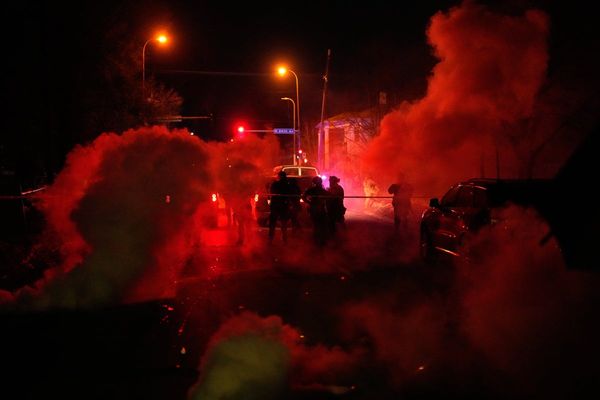SACRAMENTO, Calif. — Gov. Gavin Newsom is upset. He's frustrated because California isn't building nonstop as it did in the mid-20th century.
"People are losing trust and confidence in our ability to build big things," the governor told columnist Ezra Klein of the New York Times in a recent interview.
"People look at me all the time and ask, 'What the hell happened to the California of the '50s and '60s?' "
Lots of Californians ask one another that question.
Newsom didn't provide a clear answer in the interview. The Democrat seemed to blame the "rigidity and ideological purity" of environmental organizations and asserted that it's "really going to hurt progress."
"You can't be serious about climate and the environment without reforming permitting and procurement in this state."
That's why the Democratic governor has been trying to push 11 bills through the Legislature that would make it easier to build transportation, clean energy and water projects by cutting corners on environmental review. Environmental groups are pushing back. The fight is nearing its climax.
The governor overreached by including one highly controversial project to be expedited: A 45-mile, 39-foot-wide tunnel under the Sacramento-San Joaquin River Delta that would cost a minimum of $16 billion. The monster pipe would funnel Sacramento River water into the southbound California Aqueduct for farms and cities.
"It's a bridge too far," says state Sen. Susan Talamantes Eggman (D-Stockton), who represents part of the delta. "There's a ton of resistance" in the Legislature.
Lawmakers of both parties are furious because Newsom crammed his legislative package into state budget deliberations at the last minute, thus avoiding scrutiny by policy committees. His proposals have nothing to do with the budget.
But back to the 1950s and '60s: I asked a Newsom spokesman what the governor thinks happened to California's building boom.
"We got in our own way," Alex Stack says. "We got so good at holding up projects that we're not building them like we used to."
OK, but here are some more solid reasons:
California's population has nearly quadrupled since 1950 and more than doubled since Newsom was born in 1967. To accommodate the growth, we've bulldozed over lots of land and there are fewer places to build now — at least where there's enough water for people.
Dan Dunmoyer, president and chief executive of the California Building Industry Assn., says 71% of California is owned by federal, state and local governments and is off-limits to private development. An additional 20% is farmland. Of the remaining amount, 7% has already been developed. That leaves only roughly 2% available for new projects.
"We have 600,000 lots zoned for housing but can't get them through government permitting," Dunmoyer says.
"We just regulate housing to death in California. We regulate every single square inch of a home. It's complicated, confusing, cumbersome and costs a fortune. For that reason, they can build faster with more affordability in every other state in the nation. Faster and cheaper."
Critics place much of the blame on the California Environmental Quality Act. It's often abused by business rivals, unions seeking labor concessions from developers and neighborhood NIMBYs — Not in My Backyard — to block projects. Even environmentalists acknowledge that.
"There are some cases where the motive is economic and has nothing to do with the environment," says David Pettit, senior attorney for the Natural Resources Defense Council in Southern California. "Cases get filed that are not very good on merit."
The Sierra Club's California director, Brandon Dawson, says the Environmental Quality Act "has been taken advantage of by individuals and groups that have an obstructionist tendency."
Curiously, Newsom did not include housing and CEQA reform for homebuilding in his legislative package, a glaring omission. I suspect that's because unions disagree on the needed reforms and environmental groups have their own ideas. The governor shied away from the battle.
"We're focused on building out the infrastructure needed for housing — like water delivery, clean energy and roads and bridges," Stack says.
Another reason for the decades-long building slowdown: California has become more environmentally conscious.
We've noticed that 95% of our wetlands have disappeared. We've smelled and seen the ugly vehicle smog and refinery pollution. Salmon — let alone steelhead — don't spawn in the rivers and migrate to sea as they used to because of dams and river water diversion for farms and cities. Public access to beaches has become more difficult.
Some things that were built shouldn't have been. Just one example in Newsom's old hometown: The double-decker Embarcadero Freeway that was an eyesore over San Francisco's famed Fisherman's Wharf before it was eventually torn down.
"The 10 Freeway cut the Black community in half in Santa Monica and wiped out a bunch of homes," Pettit says. "That probably would not happen today because we have CEQA."
Maybe some housing tracts shouldn't have been built in foothills prone to wildfires.
"We've seen the downsides of poorly designed projects and overdevelopment," says Doug Obegi, an NRDC senior attorney in Northern California.
"We've built power plants in disadvantaged communities. You don't see them in wealthy communities. Poor communities bear the burdens of asthma and cancer and ill health."
We're a lot more sensitive about these things today and struggle to find a balance between development and degradation. We weigh the trade-offs and fight over them.
"CEQA was passed to address some of the large-scale projects of the '50s and '60s," Dawson says. "Large dams and public works could provide public good, but still did a lot of damage to the environmental system.
"We need to build more clean energy and water infrastructure. That doesn't mean we have to do it in a hasty manner that damages the environment."
We'll never again be on a building binge like in the '50s and '60s. In many ways, that's progress.
____







